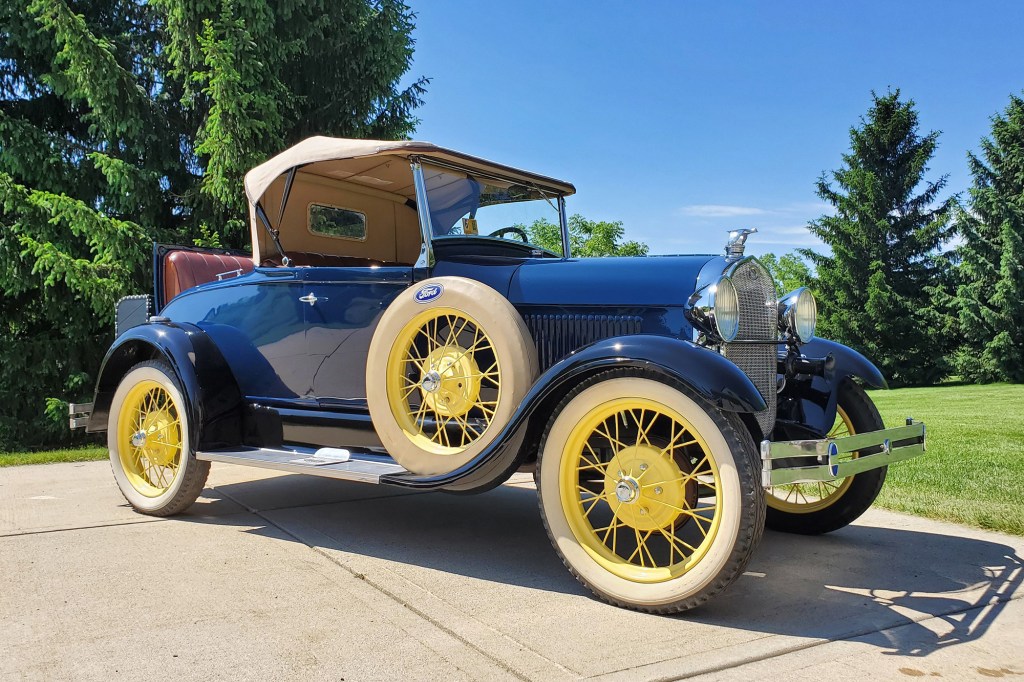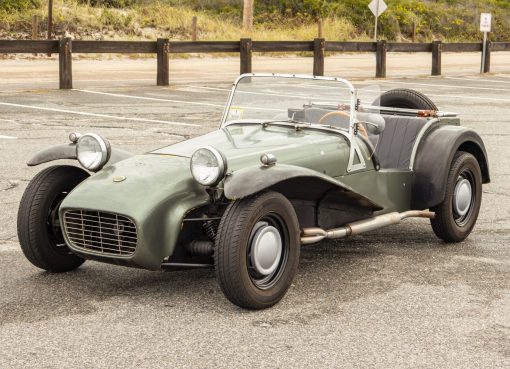Market Snapshot: 1928-1931 Ford Model A

As far as cars go, the Ford Model T, with over 15 million sold, was about as successful as Henry Ford could have hoped for in his wildest dreams. But by its final model year in 1927, Chevrolet outsold Ford by almost three to one. Ford needed a far more modern car than the tough, but rudimentary T. Fortunately, Henry’s engineers and designers delivered a follow-up every bit as successful as the Model T.
Ford manufactured more than 4.8 million Model A’s, with production beginning late in 1927 and ending in early 1932. Available in a very broad range of body types, including various open and closed-roof options as well as truck and commercial versions, the Model A has since become a staple of the collector car community. Though tastes change in this hobby, the Model A remains as a valued collector car with a thriving community of enthusiasts, clubs and businesses supporting it.
We dug deep into every Ford Model A sold via Hemmings.com since the launch of Hemmings Auctions five years ago to get an idea where values have been and where we think they are going. Read below for our detailed and in-depth interpretation of the numbers.

Enduring Appeal of the Model A
The Ford Model A possesses about everything you could want in a collector car, particularly a vintage one. It drives like any other conventional car from the 20th century with all three pedals doing exactly what you would expect them to do. The sliding-gear transmission works more conventionally than the Model T’s planetary gearbox, giving the Model A a much shorter learning curve for drivers.
The A’s 201-cu.in. flathead (L-head) inline-four was rated at 40 horsepower with the standard 4.22:1 compression ratio and single-barrel carburetor. Power was delivered to the rear axle via a conventional three-speed, sliding-gear transmission. Mechanical drum brakes operated on all four wheels. Suspension was similar to the Model T, as the Model A had transverse springs on both ends of the car. The A was good for a top speed of 65 mph, though it would be best to avoid any high-speed roads without overdrive, which brings us to another point of its appeal.

Model A parts are available in abundance, and not just for repair and restoration but also for upgrades. There are countless used parts available and plenty of new ones, too, even when it comes to performance parts. Upgrades to the cylinder head, intake, exhaust, ignition, transmission, rear end, electrical system, cooling and brakes all can enhance the safety and reliability without compromising the classic driving experience.
Given the Model A’s long-standing appeal in the hobby, specialists remain supporting the hobby, with expertise in all aspects of the car, including engine and driveline pros, body, interior—really just about any aspect of the vehicle. There are dedicated Model A clubs with active chapters all over the country, just as the models are welcomed by general car clubs. Try going to any AACA regional show without seeing at least a couple of Model A’s. Of all the calendars we publish at Hemmings, the Ford Model A calendar is the only make or model specific one we produce. And there is no shortage of people buying them every year.
A Model A fan with plenty of experience with prewar Fords, Hemmings Associate Editor David Conwill sums up the appeal of the Model A: “The 1928 to 1931 Ford Model A was a hit when new and has remained desirable to the present day in both stock and modified form. By 1954, nostalgia for the iconic Ford was fueling the birth of the modern auto-restoration hobby alongside the ongoing hot-rod boom. Thanks to its enduring popularity, well-understood nature, and strong aftermarket support, the Model A remains an affordable, fun-to-drive vehicle that is easy to restore and maintain.”

Methodology
We aggregated the data of all Ford Model A’s sold on Hemmings.com for the past five years to get a better understanding of the market for these cars. We compared the average sold price and the average price with Hemmings 5{aa25fa8b82bb550df44f4514fef8e475020994699e2c082d49d75b275e3029cc} buyer’s fee included (which is often the way most auction houses share sold vehicle pricing; it also reflects the total amount a winning bidder pays for a car). We then looked at the median as well. Finally, we also included the performance against the final reserve for those vehicles sold via auction or post-auction Make Offer in order to get a read on desirability. We did not include the direct Make Offer listings in that final figure as it reserves do not apply to such listings.
For the overall numbers, we included modified versions of the Model A, encompassing everything from period hot rod treatments to full street rods with modern V8s, suspensions and interiors. We only included running and driving examples, foregoing project cars and barn finds, though such vehicles are welcome in the Hemmings Marketplace. We also did not include no-reserve listings when comparing the performance against reserves. We might have a lot of insight here in Hemmings, but we still can’t divide by zero.

For the vast majority of collector cars, performance of fixed-roof and open-roof passenger cars can vary wildly even within one model range. The Model A is no different, so we broke the data down into open and closed cars, once again including most modified cars, but excluding commercial vehicles and closed-roof trucks.
In the general data, we did include commercial and special application Model A versions, such as fire apparatus, tow trucks, tracked vehicles, and other commercial vehicles, including Model AA trucks, sedan deliveries and similar machines. While the great variance in these types of vehicles precludes us from providing average values by specific type, their values are still relevant to the overall average and median. The many commercial applications of the Model A and Model AA promise a near endless variety of specialty vehicles available on the collector car market.

The Data
The first thing we noticed in the chart below is that the average value of Ford Model A’s sold via Hemmings Auctions and Hemmings Make Offer listings has increased 20{aa25fa8b82bb550df44f4514fef8e475020994699e2c082d49d75b275e3029cc} since 2020, with the average price rising from $20,071 to $24,158. That’s a solid performance that also happens to match nearly directly with the overall U.S. inflation rate of 21{aa25fa8b82bb550df44f4514fef8e475020994699e2c082d49d75b275e3029cc} over that same time period.
Generally speaking, that behavior is what could be expected from such a mature market as the Model A. It also tags the Model A in general as a solid hedge against inflation. Perhaps the only collector car market as comprehensive and mature as the Model A segment would be that of the Model T. But the story is a bit deeper than that and the Model A’s recent performance has actually been somewhat of a bright spot.

Tastes change in the collector car market as enthusiasts go through different stages in life and different models are “discovered” by people. Other models lose their luster, or prices fluctuate when an in-demand model has reached a certain saturation point. The Model A is no different. Prices for the Model A peaked around 2006 and fell flat from 2010 until about 2014, when values began climbing again. The bargain deals from 2012 are no longer as plentiful on the nicest examples, though driver-quality Model A’s remain a solid part of the market. There has been some fluctuation since 2014, but the past few years have shown a buoyancy and resiliency in Model A values.

Overall Market Fluctuation in 2023
Collector car prices dipped by a fair margin in 2023, particularly as inflation dug in and interest rates rose, which stifled the flow of easy capital. The Model A was no exception to this market correction, with average prices dropping an average of 20{aa25fa8b82bb550df44f4514fef8e475020994699e2c082d49d75b275e3029cc} year over year from 2022 to 2023. Prices even fell below the 2020 baseline in our data. However, when looking at the individual vehicles sold in 2023, the term “older restoration” appears in the notes far more often than not, resulting in more cars judged driver quality than concours ready. Another facet of change in the 2023 general collector car market was a marked increase in volume over recent years, so these additional Model A’s offered are not surprising. An overall increase in volume also suggests more and more people trusting the Hemmings online marketplace, a situation that inevitably means more cars of varying quality find their way to market. So far, through the first six months of 2024, prices have rebounded some 29{aa25fa8b82bb550df44f4514fef8e475020994699e2c082d49d75b275e3029cc} over last year.
One other anomaly in the data that stands out is the variance between the median and average values that has shown up in 2024. The explanation here is somewhat simple. With only a half years’ worth of vehicle volume, particularly high- or low-priced examples can readily send the two figures on divergent paths. Since the start of 2024, we have had four very strong Model A sales at $38,000 and higher, led by Hemmings own 1931 Model AA panel truck that sold for a fee-inclusive price of $53,550. The next highest vehicle after those four sold at $24,045, followed by a number driver-quality examples below that. It all adds up to a median value well below the average.

Droptop vs. a Fixed Roof
Just like most other collector cars, Model A’s with folding roofs perform better at auction. The differential over the past four years shows buyers of open-top Model A’s paying an average of 26{aa25fa8b82bb550df44f4514fef8e475020994699e2c082d49d75b275e3029cc} more than for fixed-roof models. With roadsters, cabriolets, phaetons and even open-cab pickups, there are plenty of open-air driving options when it comes to the Model A. Just the same, for the crowd that prefers to be better protected from the elements, there were also plenty of fixed-roof body styles, from standard coupes to Victoria coupes to Fordor and Tudor sedans, and town sedans, plus truck models, of course.


Performance Against Reserves
Price and desirability may seem to go hand in hand in the collector car market. When collectors first “discover” a model and the bidding frenzy begins (think: air-cooled Porsche 911s some 15 years ago as the values started running up), winning bids will frequently shatter reserves. That’s rarely the case with a model that has been considered a collectible for more than 70 years.
Reserves at Hemmings auctions are based on detailed market research and typically set in the lower half of the going market range. When a model consistently outpaces reserves, it shows a level of desirability. For the past four years, the average sale price compared to the reserve for both auction and post-auction Make Offer cars has been 26{aa25fa8b82bb550df44f4514fef8e475020994699e2c082d49d75b275e3029cc} better than reserve for all Model A’s. That number demonstrates a strong desire for the car among bidders.

Future Value
Since our reacquisition for a crystal ball remains unfulfilled, we attempt to see what the future holds by looking at the recent past market performance. Five years of data tells us that there remains a strong market for the Ford Model A, though not a huge potential for significant growth that will outpace the broader market. Matt Litwin, Editor of Hemmings Classic Car, shares his recent experience with the newfound appreciation of the Ford Model A among a new generation of collectors: “There’s been a revival of using vehicles in an ‘experiential’ manner. This is where a simpler—and let’s face it—more affordable Model A comes into play. It’s got a solid support network, can be easily altered for modern road use, and makes a perfect touring/experiential platform. All the time we see these next-gen enthusiasts, who are more apt to go places and do things with their cars.” There you have it. Get a Model A. Drive it. And when it comes time to sell it, you should expect to be able to get back at least your acquisition costs.
The post Market Snapshot: 1928-1931 Ford Model A appeared first on The Online Automotive Marketplace.

